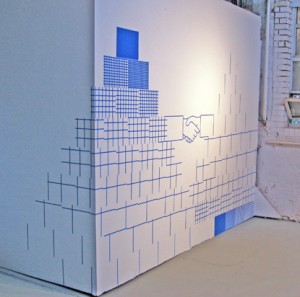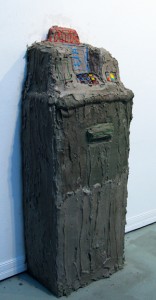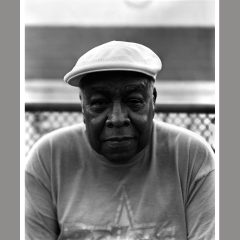At Projects Gallery, Susan B. Howard’s exhibit “Tipping Point” features expressionistic paintings of animals in natural environments. At a cursory glance, these brightly colored pieces seem to embody the harmony of peaceable kingdoms. “Actually,” Howard said, laughing when I suggested this, “each painting is more like a mini soap opera.”

On closer inspection, the paintings do show signs of discord. In A Day in the Life, the elongated form of a snake cuts across the bottom of the canvas, while a black spider dangles in the upper left corner. The animals’ eyes goggle disconcertingly, and the red halos around some of Howard’s creatures look uncannily like blood.
Considering the even balance of Howard’s compositions, it was a surprise to learn that Howard never plans her paintings before she begins. Instead, she covers her canvasses with washes, and then finds shapes in the residue to build up into animals, plants, and flowers. The result is a richly textured surface of layered paint inscribed with linear patterns. The uncertainty inherent in Howard’s work process mirrors her concerns about the fate of our natural environment. The name of her show, “Tipping Point,” signifies the natural world’s precarious future as well as the unresolved tensions between the creatures in her paintings.
Bambi Gallery features exhibits by both Matthew Osborn and Erin M. Riley. Osborn’s exhibit, “Dead Reckoning,” wraps around the main gallery space. The pieces vary in quality—some are highly rendered paintings; others are doodles on yellow legal paper—but skull, owl, spade, and ghoul motifs appear repeatedly. Intended to be viewed from left to right, Osborn’s exhibit conveys the exponential difficulty of searching for self-identify while remaining unaware of one’s origins. The final painting in the cycle, Chopping Block, depicts the inevitable conclusion to life’s narrative.

Tucked away in the back space of the gallery, Erin M. Riley’s exhibit “How’s My Driving” is more than worth seeking out. Riley approaches her woven tapestries of cars as a way to explore the father-daughter dynamic. In many cases, she feels that the car can become a man’s “baby” or replacement child. Half of the tapestries are “portraits” of the actual cars her family owned from the time she was born until the present day. The other tapestries in the exhibit feature traffic accidents: overturned cars, cars with broken windows, and black skid marks on an otherwise empty road. With Riley’s analogy in mind, these tapestries become ominous depictions of the scars of childhood abuse.

As I walked into Little Berlin Gallery’s group show “Value City,” artist Scott Bickmore was in the process of hanging an orange bicycle wheel on a wall. This, he explained, was the beginning of a collaborative, orange-themed piece that will be constructed over the course of this coming month. Anyone is welcome to work on the piece and will be compensated for doing so. Before I left the gallery, Bickmore—fittingly attired in orange clothing and sipping from a bottle of orange soda—had already garnered several contributions, including a lock hair from a redheaded visitor. Bickmore’s piece has been purchased by Hyperion Bank, where it will be installed once it is complete.

Two other pieces in “Value City” demanded attention in their innovative use of wall space. Sebastien Leclercq’s Co-opteration, a mural made from blue masking tape, juxtaposes two images from his previous works: a pyramid of grids and a handshake. As a symbol of merging, the handshake is hopeful gesture to Leclercq. However, he acknowledges that its meaning is ultimately ambiguous, since merging can imply the loss of individual identity.

Carolyn Salas’ Rug Project is a variegated and intricately patterned oriental rug. Not until I was only a few feet away from the piece did I realize that Rug Project, tassels and all, is constructed entirely from pieces of carpet foam padding. As Salas intended, I immediately felt new appreciation for the potential of this usually concealed material.

Jenna Wilchinsky and curator Masha Badinter’s contribution to “Value City” was a cake formed in the shape of an ATM machine. Visitors to the exhibit were allowed to break off chunks to eat. It’s not hard to guess how this work of art evolved—or, rather, devolved—over the course of the evening!










